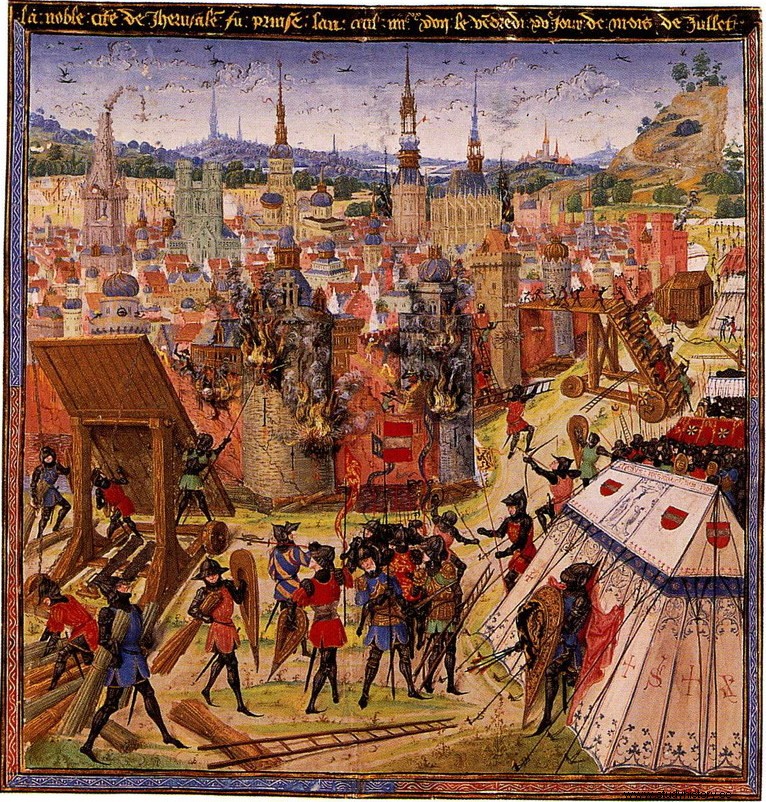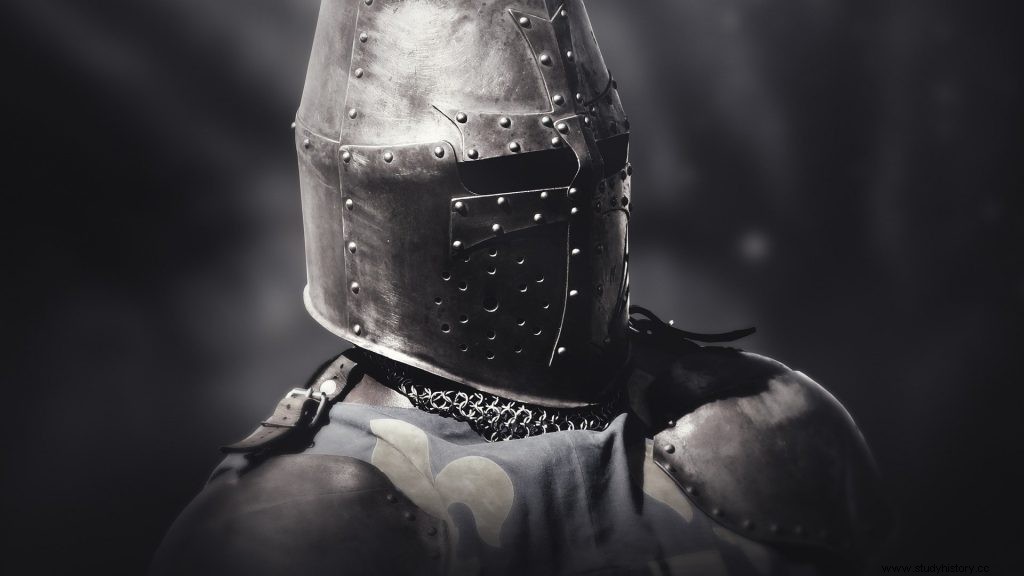The man's armor gleams in the midday sun, lances and harness jingle. On July 1, 1097 AD, Godfrey of Bouillon charged at the enemy Seljuk army on horseback, with his troop of knights next to him. As one of the first crusaders in the Middle Ages, the duke spreads fear and terror among his enemies. Especially the equipment of the riders was impressive. But who were the Crusaders and how were they equipped?
Pilgrimage with military objectives
Before we go into detail about the equipment of the knights, let's take a quick look at the origin of the crusaders. After the warlike Seljuks from today's Turkey conquered parts of the Middle East, attacks on Christian pilgrims increased. As a result, in 1095 AD in Rome, Pope Urban II called on all the warriors of Christianity to recapture Jerusalem. Many nobles, but also farmers and simple soldiers from today's France, Germany and Italy followed the call. But why were these people actually called “crusaders”?

Where does the name "crusader" come from?
Those who took the cross usually renounced all worldly possessions. At the same time, the crusaders in the Middle Ages were promised forgiveness of all sins should they die during the dangerous pilgrimage. Thus, these warriors were equal to the Christian martyrs. So that everyone could see who had taken the vow, the crusaders wore a cross on their tabard and shield as a mark. The most famous example of this is the Knights Templar with a red cross on a white background. The order of knights is also accompanied by myths about the search for the Holy Grail.
A symbol of the Middle Ages:the sword
It is the symbol of the Middle Ages:the sword, a knight's most important weapon - at least in close combat. Swords of the typical crusaders have a length of about 100 cm. The sword hilt, also known as the hilt, ends in a pommel that is often richly decorated for proper support and as a counterweight. Various knob shapes were common, such as the Brazil nut, the wheel, the disc and, rarely, the mushroom knob.
To protect the hand, crossbars are attached to the lower end of the iron blade, which is sharpened on both sides. Finds of high medieval swords with crossbars that have a bend towards the site are extremely rare. Most swords of the High Middle Ages have a straight crossbar. Crusaders carried their weapon in a hip-worn scabbard for safekeeping.
Brutally effective:the crusader and his lance
Recall the scene from the beginning:A troop of 50 heavily armored horsemen gallop towards the enemy. In such an attack, the lance plays the most important role as a knight's second main weapon. Lances consist of an approximately 2.50 to 4 meter long, solid wooden shaft with an iron tip. The stirrup gave the rider enough support to put the weapon under the armpit. The force of the impact could penetrate light and medium armor with ease.
We are often asked what the difference between spear, lance and pike (in the Middle Ages) is, so we would like to go into this very briefly. If you look at the origin, there is none. All these designations go back to one of the oldest weapons of mankind:namely the stick, which was sharpened for hunting. But depending on where you look and with whom you read, there are still (usually quite vague) definitions. They refer namely to the later use.
For us, the most consistent distinction for use in the Middle Ages is the following:A spear is a throwing weapon and therefore has certain properties that make it ideal for this purpose. As a rule, the shaft is less robust and shorter than that of a lance and spear. This makes it less suitable for close combat, but it usually has more aerodynamic properties. (But that doesn't mean you can't stab with it if you have to.) The medieval pike, on the other hand, is much longer and heavier than a spear as a polearm. The leaf could be different, for example with barbs or with the so-called wings. And last but not least, to put it very simply:the lance is the spear of the rider. If anyone finds another explanation more conclusive, bring it on.
Armor in the Middle Ages:good protection in transition
Speaking of armor, these days we can't imagine a Crusader without iconic armor. In the beginning, the brave warriors usually wore ring armor and helmets, less often also scale armor. The ring armor usually consisted of hauberk (knee-length chain mail with long sleeves), chain hood and Diechlingen (chain leggings).
From the 13th century armor became heavier due to the use of plate parts. As a result, the armor offered effective protection against the weapons used by the Muslim troops, such as bows and arrows or light sabers.
Shield protected the Crusaders from attack
In addition to armor, most Crusaders carried a wooden shield in their off-hand. This was used to parry blows and deflect arrows. The shield was often reinforced by a metal hump and metal strips and was carried slung over the shoulder. Extending from the ground to the shoulder, a shield provided ample protection for the warrior's entire body. The shield usually had a cross or painted coat of arms of the family or lord to which the crusader belonged.
With great helmet, charm and mail
A knightly fashion show would be accompanied by a heavy clinking of chains:the ring armor or chain mail in the Middle Ages reached down to the knees and protected the body, arms and legs. A chain hood often promised protection for the head and neck. The crusader of the world wore a pot helmet or a Norman helmet with nose protection. From the 13th century a breastplate was placed above it. A pretty tunic as the top layer and a gambeson as an undergarment for padding under the chain mail and you were ready to start with the craft of war.
Other weapons of the Crusaders in the Middle Ages
Less commonly found on the battlefield were other medieval Crusader weapons, including the single-bladed battle-axe and the mace, with four or six sharp metal blades attached to the end in a star shape. The battle hammer is modeled after a blacksmith's hammer and could cause deadly wounds as a bludgeoning weapon. A morning star is a shaft with a spiked iron ball attached to a chain at the end. The momentum of the bullet created a very dangerous and formidable weapon capable of penetrating heavy armor.
Biggest problem:the weight
When you try on your equipment for the first time, you will quickly notice that armor, shields and weapons weigh a lot that should not be underestimated. In the Middle Ages, crusaders therefore had to carry out regular weapon training as part of their training. Toughness, endurance and strength made the fighters serious opponents. The weight of a sword and its sharpness meant that a targeted blow was often enough to eliminate the opponent. The opposite side of the Seljuks and later the Saracens used a different kind of warfare.

Differences in warfare between Crusaders and their enemies
In the Middle Ages, two worlds collided during the Crusades:Orient and Occident. While the Crusaders relied primarily on brute force, strength and endurance in close combat, the Muslim troops focused more on bows and arrows. The mounted archers charged the crusader armies from afar, then quickly rode away. Almost invincible in close combat, tiredness and hail of arrows hit the horses and unarmored troops of the crusaders in particular. If it then came to a field battle, the enemies were mostly crushed.
In the Middle Ages, the crusaders mainly used lances, swords and horses for their equipment. The fighters were protected by chain mail, pot helmets or helmets with nose protection and shields. Breastplates were later added to protect against heavy projectiles such as crossbow bolts. As rarer weapons, the Crusaders used battle axes, maces, morning stars, and war hammers. And which equipment would you choose?
Cover image:Sent in by Dennis DeBiase for Photo Battle 2019.
